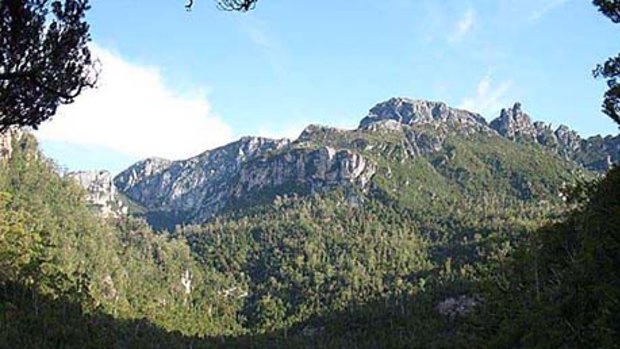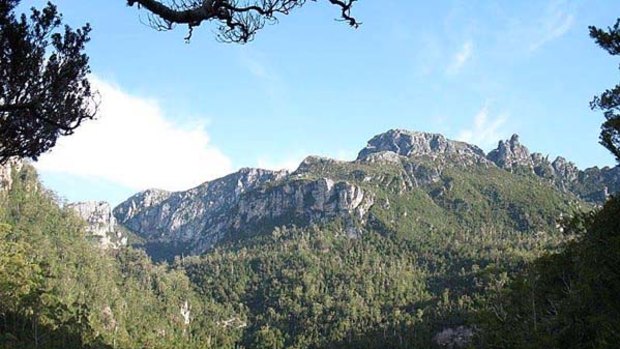
The view across Lake Vera in the Franklin-Gordon Wild River Park.
Mike Van Niekerk goes off the grid and knee-deep into the Tasmanian wilderness.
Mark said "stop a minute," and we paused to soak in the deep, cathedral quiet of the rainforest gully on the way back down from the heights of Frenchman's Cap. Ahead of us, now out of earshot, Peter and Zane had bounded down the steep, broken and treacherously slippery trail that dropped from Barron's Pass through a vale of myrtle-beech, sassafras, grasstree-like pandani and the odd huon pine.
The sun speared the upper canopy here and there, but mostly we were passing through a cool, wet and mossy under-storey of exposed roots, knotty trunks and collapsed trees slowly turning to mulch. After a few moments of reverential silence I moved forward, reactivating the searing burn of my thighs.
Even though my pack had been substantially lightened by eating through three days of food and fuel at the Lake Tahune hut below the summit, my suffering muscles had a long way to go to recover from the over-enthusiastic pace of the climb up to the hut earlier in the week.
We were now descending to the lower hut at Lake Vera, wondering if finally we would have some company from other adventurers on this, one of the most challenging hikes in the Franklin-Gordon Wild Rivers Park in Tasmania's South West, but we didn't see another soul until we were about to cross the Franklin River on the way out to the Lyell Highway two days later.
Selfishly, perhaps, I liked the idea that the four of us were alone in the wilderness, out of range of communication and other company, a long, long march to the nearest road. Where the stimulation of a busy life is stilled by the sound of deep quiet in a remote, temperate rain forest. Not even an emergency phone call could get to us here. For more than a week, we were off the grid.

The view across Lake Vera in the Franklin-Gordon Wild River Park.
Frenchman's Cap is a 1443m peak that can be seen from many parts of the island's south-west and even off the west coast, up to 100km away, from where early mariners saw and named it, apparently after a style of Gallic headdress in the early 19th century. It's the high point and the turnaround of an out-and-back hike that some fit enthusiasts complete in four days, but we were planning to take our time over seven nights and eight days.
After flying to Launceston early on a Sunday morning, we were met by Trevor, our chauffer-for-hire who took us via a quick detour into town for fuel and Parks and Wildlife Service permits and a three-hour drive to a carpark alongside on the Lyell Highway.
We registered our intentions in the logbook just before the swing bridge over the Franklin River and then set off on the slow ascent of Mullins Ridge that then led down to the Loddon River and across it into the feared Loddon Plain bog.
Crossing the bog is a slow, difficult and messy business. The sludgy pockets of mud and water that 1000 hikers a year gouge into the heath and tea tree landscape of the poorly-drained soil give no indication of depth. One step forward may come to rest on firm footing in an inch of water, the next may swallow your leg up to the knee. The day we walked in, I tried to dance my way around the dark mud holes, slipping and sliding, grabbing fistfuls of tea tree and jumping from one firm-looking clump to the next, trying to stay balanced with the pack on my back.
A week later, on the way out, boots and gaiters now thoroughly muddied, I strode as directly ahead as I could make it, but didn't seem to move any faster than my companions who were doing the "Soddon" Loddon dance. On one occasion the mud held me fast above my calves and I had to be pulled out of the suction from a nearby bank.
Frenchmans Cap enthusiasts talk fondly of the Loddon Plain's boggy barrier. The rewards on the other side are all the sweeter for the effort. Plus its reputation has undoubtedly deterred the less hardy and made the experience more exclusive. So its with some regret that the purists look upon the donations of businessman and adventurer Dick Smith who, having visited the Cap in 2008 with his wife, resolved to smooth the path for succeeding generations.
Over a period of 10 years, Mr Smith is donating $100,000 a year to the WILDCARE Gift Fund, a donation matched by $50,000 a year from the Tasmanian Government, to upgrade the track and install duckboard walkways. In May 2010, only some overdue maintenance work was visible along with some early, short sections of new planking and duckboard. For myself, I was grateful for the few stretches of level walking and look forward to returning when the project is complete or close to. The toughness of the rest of the hike is self selection enough.
Having left the Lyell Highway around 2pm we were expecting to run out of time before sunset at 5.30pm, long before the end of the 16km march to the first hut, so as light was fading we halted at one of the two relatively dry and forested patches to put up our tents. Just in time it turned out. Fifteen minutes later and we would have been flailing through the bog with the added challenge of navigating the way on a moonless night.
Later, In the dead of night, as if in a dream, I was forced to step over wayward guy ropes in our quiet hollow to shoo away the dark shape of a wombat which had been crunching into a powdered milk container that we had thought was cunningly safe hanging from a branch. It was a cold, hard, damp and constricted place to spend the night so we were especially pleased after a vigorous, two-hour march in the morning to come around a corner and find the relatively palatial Lake Vera hut.
Thick stands of tea tree hides the lake from the hut, but its four cushioned sleeping platforms and big living area makes it very comfortable, along with a pot-bellied stove that is fueled by a bunker of coal alongside a helipad.
We enjoyed the Lake Vera hut for two nights and days, but it was when we pushed on to the Lake Tahune hut that the full glories of the Frenchmans Cape hike revealed themselves.
First, the climb up to Barrons Pass, as steep and physically taxing as it was, especially with a 20kg pack, takes one through the magical under-storey I described earlier. When we crested the pass, the majestic Cap with its trim of snow came into view across a valley studded with jet-coloured tarns; and then disappeared back into the cloud that covered most of the sky for the next couple of days.
So late in the season, average rainfall and cloud cover increases, but any time of year is a gamble on this hike. We amused ourselves at the two huts reading aloud from the comments books, and as many enraptured entries as there were describing crystal-clear skies and views from the summit right across to Macquarie Harbour, there were grim records of being beaten back down from Barrons Pass by wind and snow, of rain and of perpetual cloud - even in January.
From Barron's Pass its a tricky scramble, at one stage up a steep ladder, to arrive at Lake Tahune. Now more than 40 years old, the fibro hut here is much smaller and less comfortable, heated only by a primitive kerosene heater and with walls and ceiling that drip condensation. For two days we huddled in the hut, waiting for the clouds to lift so we could make the final push to the summit. Defeated, we packed and left on the third day. Having got 100 meters down the trail I looked back and saw the clouds part to show a teasing glimpse of the summit.
Just over an hour later, having raced back to dump our packs in the hut and push on up, we were standing on the summit - once again hemmed in by icy cloud. The spectacular view had evaded us but we were pretty pleased nevertheless that we had been tricked to the top. Even cloaked by cloud, clambering up the steep slopes and across the snow drifts had been envigorating - and there was also the achievement of summiting.
There was further consolation early the next morning, Standing on a precipitously-positioned helipad near the hut, to watch the leaden cloud unexpectedly snatched away to reveal the breathtaking sight of multiple peaks below my feet, rolling away towards the horizon.
Several days later, we were once again on the other side of the Franklin River, changed into dry clothes and waiting for our lift to the airport.
The hike had been physically and mentally challenging. I had often been cold, sore and uncomfortable. Despite a bit of duckboard here and a warm hut there, eight days in the wilds is not a walk in the park. Yet it had been uplifting and profoundly satisfying to be able to experience such a vast and ruggedly beautiful wilderness - and so close to home in Melbourne.
Sign up for the Traveller Deals newsletter
Get exclusive travel deals delivered straight to your inbox. Sign up now.